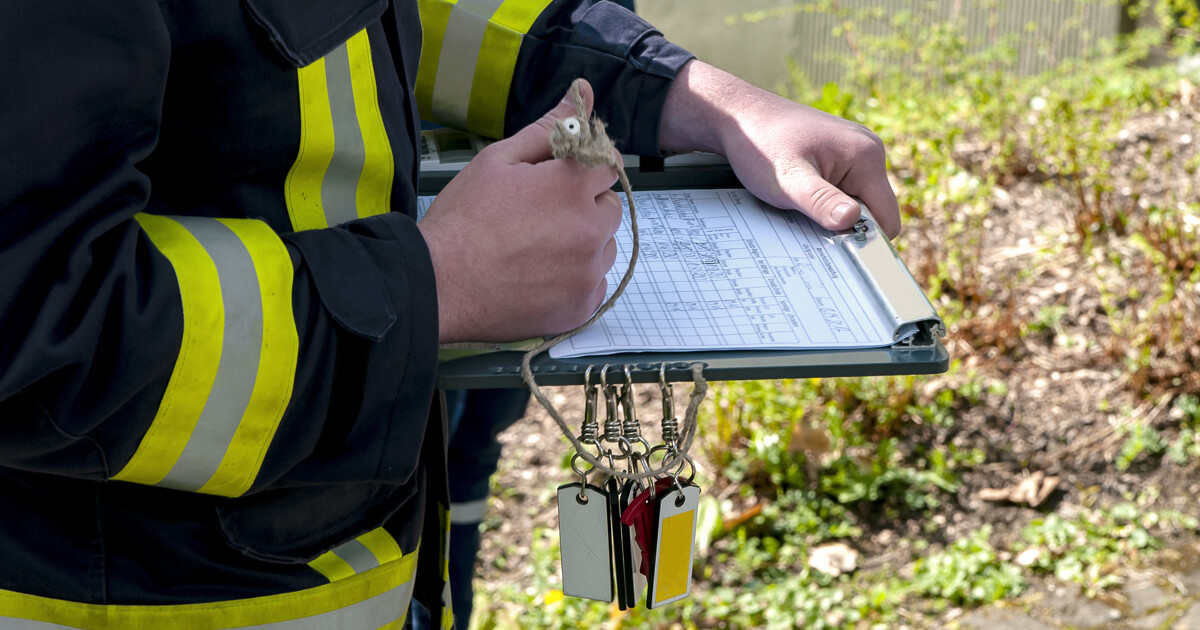Industry Articles

Who Issues A Fire Safety Notice and What To Do Next
Most people know how vital fire safety is, whether it is in the home, in a public place, or at work. However sometimes it can be difficult to know what measures to take, and why they matter. If you are the Responsible Person (RP) in your workplace, there are certain measures you should take to ensure your premises meet safety standards. As the RP, you are expected to organise the safe evacuation of everyone on the premises in the event of a fire or other emergency. It is also a legal requirement to carry out a fire risk assessment wherever there are people working.
But who enforces these standards, and how are they controlled? We’ve put together this short article to clarify all things fire safety and to make sure you know the ins-and-outs of Fire Safety Notices and how they work.
Who Issues A Fire Safety Notice?
If there is a problem with your Fire Safety Measures, you may receive a Fire Safety Notice. These are issued by Fire Safety Officers from your local Fire and Rescue authorities. In Dorset, we rely on the Dorset & Wiltshire Fire and Rescue service, with locations in Dorchester, Poole, Christchurch, and Swindon. You can find your closest station in Dorset and Wiltshire with this online tool. For stations in Hampshire, try this Fire Station Locator.
What is the main piece of legislation concerning fire safety in the workplace?
Fire-safety regulations are covered in the Regulatory Reform (Fire Safety) Order 2005.
Before 2005, there were several pieces of legislation on fire safety and it was often complicated to gather all of the necessary information. Therefore, it was decided to bring everything together under one piece of legislation. By doing this, the rules surrounding Fire Safety became unified and easier to understand and find. It was hoped that this would increase understanding and Fire Safety compliance.
What is the Regulatory Reform Fire Safety Order 2005?
The Fire Safety Order was introduced in England and Wales in October 2006 and applies to almost all kinds of premises and buildings including:
- Shops
- Offices & workplaces
- Care homes & hospitals
- Pubs, clubs, restaurants
- Community builds (i.e. places of worship, halls, libraries)
- Factories & warehouses
- Hotels, hostels & BnBs
- Shared areas in accommodation
- Schools
In effect, it applies to virtually any public place. The Fire Safety Order does not cover domestic premises, which includes private homes or flats within a larger block.
We have helped a number of building-types to meet safety standards, from museum heritage buildings and care homes to schools and hotels. Check out our case studies for examples of our work and the solutions we find for our customers.
The Order places the responsibility on employers and/or other Responsible People to carry out Fire Risk Assessments and identify risks as well as Fire Emergency Evacuation Plans.
It lays out the main standards for fire safety and is used by enforcement authorities as well as businesses to understand what is expected of them.
The Fire Safety Order sets out a large amount of information concerning fire safety regulations, including the kind of maintenance that needs to be in place, the required training of RPs, as well as general duties and what information must be provided to employees.
The main points from the Fire Safety Order are as follows:
- Carry out a fire risk assessment. This can be handed over to a competent person or organisation, but remains the responsibility of the RP. Here at Dorset Fire Protection, we offer a number of services to help you comply with the Fire Safety Order.
- Identify the dangers and hazards
- Consider who may be at heightened risk (a PEEP may be required)
- Reduce the risk of fire
- Provide precautions
- Take measures to ensure flammable materials are stored safely
- Create Emergency Evacuation Plans and make sure the necessary people are aware of these
- Record and review your findings, precautions, and plans
The government has also published a number of official documents to assist business owners and other non-domestic premises in their fire safety measures. As the guidelines can be overwhelming and confusing it may be more constructive for you or your designated RP to contact us here at DFP for professional help with your fire safety.
The Regulatory Reform Fire Safety Order is the go-to guide for fire-safety concerns, laying out both the duties of individuals and the Fire Rescue Service’s enforcement duties too.

Who enforces the Regulatory Reform Fire Safety Order?
Fire and Rescue Services enforce the 2005 Fire Safety Order by making visits where they assess the Fire Risk Assessment Measures, Evacuation Plans and exits. The Fire Safety Officers will carry out inspections following certain guidelines on risk factors depending on the premises type.
A few exceptions apply to certain premises where other enforcement authorities are allocated. The places with differing enforcement authorities are rare and apply only to certain cases like sports grounds, prisons, young offenders institutes, immigration centres, detention centres, and other government official buildings. The enforcement authorities for these will vary but are mostly the local authorities responsible for issuing safety certificates at sporting grounds, Health and Safety Executives, the Secretary of Defence fire service, Her Majesty’s Inspectors of Fire Services and any other state-appointed bodies for Crown-owned or occupied premises.
When the Fire Safety Officers visit, they will assess several factors regarding fire safety standards such as your workplace in general, as well as its activities, the fire safety management on the premises, and your fire evacuation plans. An audit of your fire risk assessment will also be completed to ensure you comply with fire safety law. They will check that your fire prevention and fire risk assessment measures are adequate.
During these inspections, the Fire Safety Officers should give you feedback and advice on how to comply with fire safety laws.
Who is responsible for fire safety in the workplace?
The RP is responsible for fire safety in the workplace. This can be the employer, the owner, the landlord, an occupier or anyone else with control of the building, or part of the building. Sometimes there might be more than one RP for the premises, and in this case, the RPs must work together to share the responsibilities and ensure everything is covered throughout the building. The RP is responsible for all employees as well as anyone lawfully on the premises.
See how the RP of this care home took action by getting us to help them fulfil their fire safety requirements.
Why is it important to follow fire safety laws?
It goes without saying that following fire safety laws is important. Following Fire Safety laws significantly reduce the risk of fire.
The law is clear, and no exceptions can be made. When the local Fire & Rescue Services inspect your property, if they find anything they deem as inadequate, they have a number of routes to take. Some include informal suggestions and guidelines, orders, or even penalty fines.
Complying to fire safety regulations is more than just a tick-box exercise, however, it’s a matter of protecting the health of everyone in the building. Following fire safety laws not only prevents unwanted fines and repair costs, but it also avoids injuries and saves lives!

What types of Fire Safety Notice can be issued?
If the Fire Safety Officers deem your fire safety measures unfit, they have several procedures to take. They usually provide people with guidance to improve their safety standards and sometimes start with issuing an informal notice suggesting recommended safety measures.
However, if the issues highlighted are too serious, then the following fire safety notices can be applied:
- Alterations Notice: this notice is issued if your premises has high safety risks or would have safety risks if the use of the building changed. With this notice, the RP must notify the local Fire & Rescue Services of any changes that may affect the fire safety risk of the premises. The notice will detail what type of changes you must notify them about. It is a way of both notifying the local Fire & Rescue Services of potentially high-risk buildings and of notifying the RP that their premises is of high or potentially high risk. An Alterations Notice is issued at the discretion of the local Fire & Rescue authorities. Within the notice, there should be a full explanation detailing the reasons behind it. The notice can be delivered by hand, through the post, or left at the address. It can be sent electronically if you have agreed previously to accepting services from the Fire and Rescue Services this way. No timescale is issued with this type of notice.
- Enforcement Notice: an Enforcement Notice means that the Fire Safety Officers found the premises do not comply with certain measures of the Order, and therefore has inadequate fire safety measures. The notice should explain the issues found and must give advice on the solution(s) to solve the issue found. The RP must be given 28 days to make the necessary changes.
- Prohibition Notice: the most extreme notice that can be given. These notices prohibit or restrict access to parts of or the whole premises, depending on the level and size of risk(s) found. These notices are given when serious risks are identified by the inspecting authority. The notice will specify the problems found and lay out ways of correcting the failures. The authorities will decide when the notice will take effect, but in some cases, the notice can take immediate effect, should the authorities decide that there is an imminent risk of serious personal injury.
Who has the power to initiate a prosecution in relation to fire safety?
Local Fire and Rescue Authorities have the power to initiate a prosecution, should there be serious breaches of legislation and if no action has been taken to amend issues highlighted in Fire Safety Notices.

What is the maximum fine for a minor penalty from a Fire Safety Officer?
If Fire Safety measures aren’t followed, Fire Safety Officers can issue fines of up to £5000 for minor penalties.
What is the maximum fine from a Fire Safety Officer?
Major penalties, however, can have unlimited fines and even lead up to 2 years in prison.
Fire Notice Appeal
If you disagree with the decision, you can go about this informally, by discussing the decision with the enforcement authorities.
Alternatively, appeals can be made to your local magistrate’s court within 21 days of receiving the notice.
By appealing a notice, it is suspended until a decision is made. For prohibition notices, however, this is not the case due to the esteemed risks involved. In the case of prohibition notices, they will take effect and only be suspended if the court directs it.
The courts can affirm a notice in its original form or with modifications, or cancel it altogether if the notice is deemed inappropriate.
How much does a Fire Safety Plan cost?
A Fire Safety Plan can vary in cost, depending on your premises and the size of your workforce. Get in touch with us today to discuss your requirements.
Summary
We have compiled this guide to Fire Safety Law and Notices to help businesses and non-domestic premises understand the many rules surrounding Fire Safety Law. It is a highly important matter and deserves time and attention. Here at Dorset Fire Protection, however, we do understand that it is a confusing, and sometimes worrying matter, so if you need some expert advice, or services such as fire safety training, fire alarm installation, fire safety maintenance or fire risk assessments, or contact us today.
Please get in touch on 0330 7000 555 or visit us Mon – Fri 8.00am – 4.30pm.
You can find us at the following address:
DFP Global Ltd,
Inspiration Place,
1-4 Mitchell Road,
Fernside Park,
Wimborne
BH21 7SG



